
Bishop Noda lowered his voice as the dishes were cleared one evening in his modest home - he had something important to tell us.
"Have you both been to the great shrine of Izumo?"
Indeed, we both had. He was referring to Izumo Taisha located in the next town over, reputedly the oldest extant Shinto shrine in Japan and the chief tourist attraction in this forgotten corner of the country. I had previously served in the town hosting the shrine and had been there several times.
"You know that inside the shrine are various secret symbols of the deity that few people have ever seen?"
Did I ever. Discovering the contents of the Holy of Holies of Shinto shrines had become a significant diversion for me as a missionary. Occasionally, I had some success at finding smaller roadside shrines with their doors left open, and one time I made my companion press through a crowd with me at a shrine festival to get the best possible view of the head priest heading into the Holy of Holies. Later, I studied Shinto obsessively and learned that the object standing in for the deity in most Shinto shrines was usually an old bronze mirror or, less often, and old sword or curved jade bead.
And I don't call it the Holy of Holies for nothing - similarities between the layout and function of Shinto shrines and the temple, specifically the ancient Hebrew tabernacle and temple, are striking and had a lot of currency among members and missionaries as a shadow of proof that the Japanese people were literally one of the ten lost tribes. (It only helps that anthropologists and linguists still can't offer much in the way of an explanation for the origin of the Japanese race or language.) A member of the 82nd generation of the Senge family, in an unbroken line, serves as the high priest of Izumo Taisha and only enters the Holy of Holies once or twice a year during certain festivals. And apparently, no one else ever does.
A tantalizing possibility appears in the writings of Lafcadio Hearn, an Irish-Greek-American who lived in this town in the 1880s and wrote extensively of what he saw. His slice-of-life portraits of painted geisha jostling with two-sworded samurai as they clickety-clack over curved wooden bridges, sculpted gardens and temples illuminated by rows of paper lanterns, and ghostly spirits rocking the foundations of the town's medieval castle illustrate the possibility that this was once a fully realized foreign world, before the successive waves of globalization took their toll. Hearn wrote a letter to the then-serving high priest of Izumo Taisha and, in return, received an invitation to visit its Holy of Holies. He described this experience in Chapter 8 of his most famous compilation, "Glimpses of Unfamiliar Japan," where he noted that he was the first (and undoubtedly last) foreigner to ever be granted such a privilege. Ultimately, it appears that the image of the main deity was further enclosed in a shrine within the shrine which was not opened for him, but he still came fairly close.
"I once heard that the high priest of that shrine gave a talk and let a secret slip about the contents of the shrine...."
My curiosity was piqued.
"The priest said that one of the objects representing the deity is a stone with a Hebrew character inscribed on it. It was said to have been carried from a distant land where the Japanese race came from and enshrined here in Izumo by the clan that settled here. They researched lots of different writing systems and concluded that the character was definitely Hebrew."
And then it all made sense. It may or may not be the case that one of the oldest and largest shrines in Japan really contains an ancient and secret Hebrew inscription. More likely, it meant that the great shrine tangibly connected Bishop Noda and those he served in his small ward to something greater - the Gathering of Israel, the lost Ten Tribes. Who was I to tell him anything different?
No comments:
Post a Comment